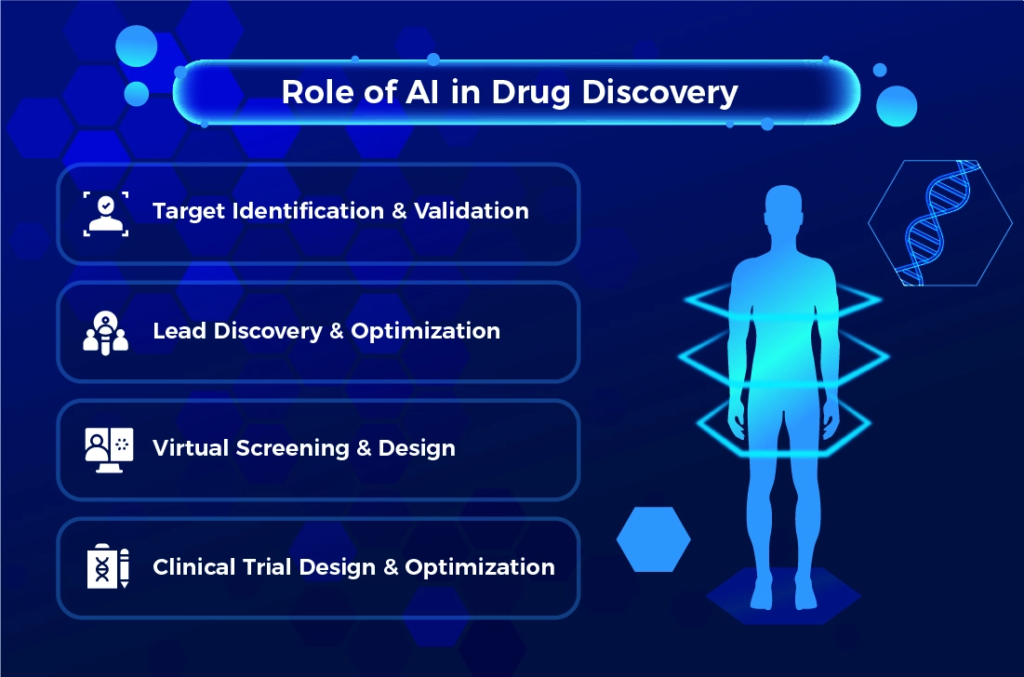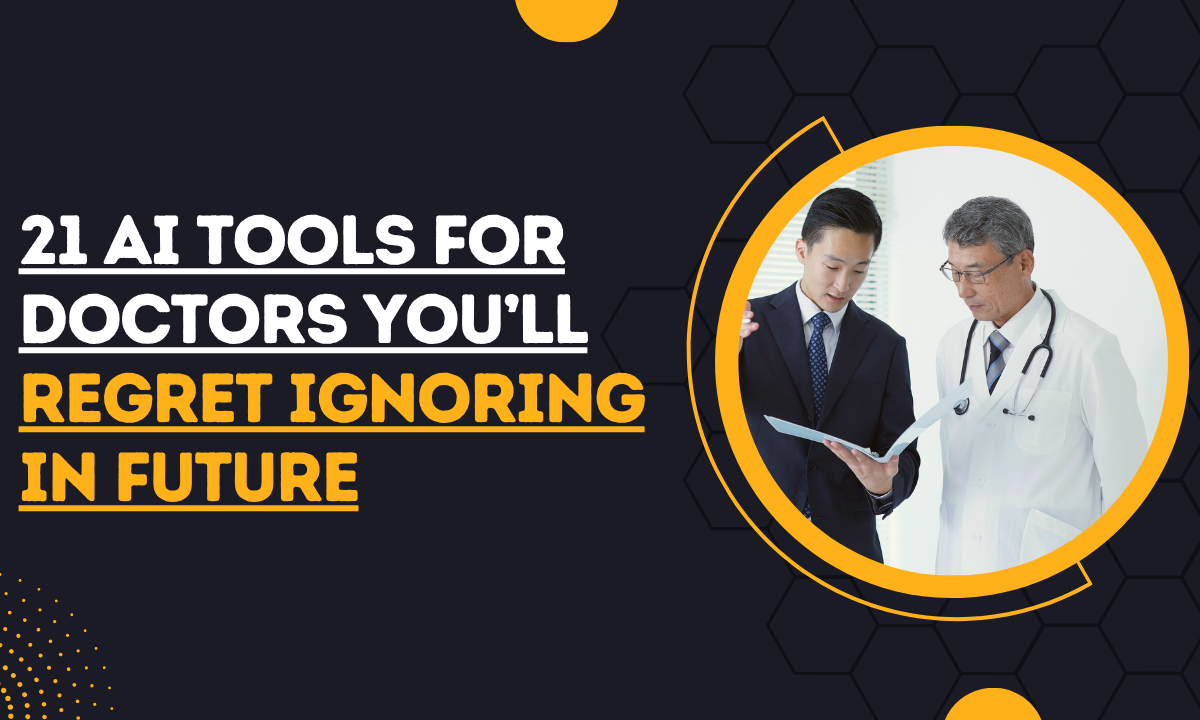21 AI Tools for Doctors You’ll Regret Ignoring in 2025
AI tools for doctors are fast becoming the backbone of modern medicine. From reading X-rays in seconds to drafting patient notes in real time, these tools are reshaping how you diagnose, treat, and even think about care.
But here’s the shift: it’s not just about efficiency anymore. It’s about survival in an ecosystem where data, speed, and precision define success.
According to a 2024 McKinsey survey, 85% of healthcare leaders across payers, health systems, and HST groups were exploring or had already adopted AI capabilities.
So, what does that mean for you?
It means that the earlier you integrate AI into your practice, the more resilient your medical decisions—and reputation—become.
Because in today’s healthcare landscape, technology doesn’t wait for hesitation. It rewards adaptation.
Diagnosis / Imaging / Clinical Decision Support
| # | Tool Name (Live Link) | Role | Use Cases |
|---|---|---|---|
| 1 | Aidoc | Real-time AI platform for radiology that detects and prioritizes critical findings like hemorrhages, fractures, or embolisms. Integrates seamlessly into radiology workflows to enhance speed and accuracy in diagnosis. | • Scans CT/MRI in real time for abnormalities. • Alerts radiologists instantly for urgent cases. • Reduces turnaround and diagnostic delay in emergency care. |
| 2 | Lunit | Lunit uses advanced AI to assist radiologists in detecting cancers and other abnormalities from medical images with high accuracy and speed. | • It’s widely applied in chest X-rays and mammography to identify early signs of lung and breast cancer, supporting faster diagnosis and improved patient outcomes. |
| 3 | Arterys | Cloud-based medical imaging AI platform offering automated quantification for cardiac and oncology scans. Enables secure collaboration and remote interpretation through cloud access. | • Quantifies cardiac structures and tumor volume. • Tracks treatment response across visits. • Allows multi-institution sharing for second opinions. |
| 4 | Qure.ai | India-based medical imaging AI specializing in chest and head scans. Offers accessible diagnostic support to clinics without radiologists, enabling faster triage decisions. | • Detects TB, pneumonia, and lung nodules on X-rays.• Identifies brain bleeds or stroke changes on CT.• Ideal for low-resource rural diagnostics. |
| 5 | Caption Health | AI system that guides healthcare workers to capture high-quality ultrasound images. Makes diagnostic imaging more accessible to non-specialists using real-time feedback. | • Directs probe angle and positioning during scan.• Ensures optimal image capture for diagnosis.• Expands ultrasound use in underserved areas. |
| 6 | PathAI | AI platform for pathology slide interpretation that identifies cancer cells, grades tumors, and finds biomarkers. Enhances consistency and objectivity in diagnostic pathology. | • Detects cancerous tissue patterns in slides.• Reduces human variation in diagnosis.• Assists in treatment planning through biomarker detection. |
Drug Discovery & Research / Bioinformatics

Source: Bacancy
Have you ever wondered how new drugs reach your pharmacy shelves so fast today?
Interestingly some AI tools for doctors are playing a quiet but revolutionary role behind the scenes.
They sift through massive chemical libraries, predict molecular interactions, and flag potential candidates for further testing.
You don’t have to be a chemist to appreciate the speed this brings—what once took years can now happen in months.
AI tools also analyze patient data to predict drug responses, helping doctors and researchers tailor therapies more precisely.
| # | Tool Name (Live Link) | Role | Use Cases |
|---|---|---|---|
| 7 | Insilico Medicine | Generative AI platform for end-to-end drug discovery, integrating molecular design, target identification, and biomarker prediction for faster, data-driven R&D. | • Designs novel compounds for specific diseases.• Predicts molecule toxicity and efficiency.• Accelerates lead optimization. |
| 8 | BenevolentAI | AI-driven knowledge graph that maps biomedical relationships to identify drug targets, repurpose drugs, and generate research hypotheses. | • Finds new drug-target connections.• Prioritizes repurposing opportunities.• Speeds hypothesis generation for new studies. |
| 9 | Atomwise | Deep learning model predicting how molecules bind to proteins, revolutionizing virtual screening in preclinical research. | • Predicts binding affinity of compounds.• Narrows large molecule libraries.• Accelerates hit identification in drug discovery. |
| 10 | BioXcel Therapeutics | Uses AI to identify new uses for existing drugs by analyzing clinical, genomic, and real-world data. Reduces R&D costs and timelines. | • Discovers new indications for old drugs.• Integrates cross-domain datasets.• Accelerates clinical trial readiness. |
| 11 | Valo Health | Unified AI and data platform that simulates drug development through digital twins, bridging preclinical insights with patient-level outcomes. | • Connects molecular to clinical data.• Simulates patient trials virtually.• Optimizes design of future studies. |
Clinical Workflow, Documentation & Virtual Assistants
Ever feel buried under patient notes and administrative tasks?
Here’s where some AI tools for doctors are transforming clinical workflows, making documentation less of a chore.
Imagine dictating your notes and having an assistant automatically structure them into the patient record—accurate, fast, and organized.
Virtual assistants powered by AI also help with scheduling, reminders, and even triaging patients.
| # | Tool Name (Live Link) | Role | Use Cases |
|---|---|---|---|
| 12 | Nuance DAX (Dragon Ambient eXperience) | Ambient AI that listens to patient encounters and drafts medical notes automatically. Reduces administrative workload and enhances patient engagement. | • Captures consultations in real time.• Auto-generates clinical summaries.• Frees doctors from manual typing. |
| 13 | Suki AI | Voice-enabled assistant for clinicians that transcribes notes, codes diagnoses, and inputs data into EHRs through natural speech. | • Converts dictations to structured notes.• Suggests billing codes.• Cuts documentation time significantly. |
| 14 | Glass AI | AI-powered reasoning engine for clinicians that synthesizes patient data and literature to support complex diagnostic thinking. | • Processes clinical inputs to suggest differentials.• Retrieves latest evidence automatically.• Acts as an intelligent diagnostic collaborator. |
| 15 | Robin | Robin by Medflix is an AI assistant built for doctors, offering 20+ smart tools to automate tasks like summarizing trials, drafting abstracts, generating consent forms, and creating presentations. | •It helps physicians save time in clinical work by turning context you provide into polished outputs—differentials, topic briefs, tailored medical documents, and more. |
| 16 | Sensely | Virtual nurse avatar that engages patients through voice and visuals, offering symptom triage and follow-up management. | • Checks symptoms interactively.• Guides patients to right care levels.• Provides medication and appointment reminders. |
Patient Engagement, Telehealth & Remote Monitoring

Source: VCDoctor
Ever feel like staying on top of your health is a full-time job?
The fact is that AI tools for doctors are changing that.
They help doctors monitor patients remotely, flagging early signs of trouble before symptoms become serious.
Telehealth apps powered by AI allow real-time consultations without leaving home.
Imagine your doctor reviewing your vitals, spotting trends, and sending personalized advice—all virtually.
Engagement isn’t just convenience; it improves outcomes.
Studies show patients monitored remotely are 30–50% less likely to be readmitted after hospitalization.
AI can analyze sleep patterns, heart rate, and medication adherence, giving doctors actionable insights you wouldn’t notice yourself
| # | Tool Name (Live Link) | Role | Use Cases |
|---|---|---|---|
| 17 | Ada Health | AI-driven symptom checker that uses adaptive questioning to suggest likely conditions and guide next steps for users. | • Evaluates symptoms conversationally.• Recommends care actions.• Reduces unnecessary doctor visits. |
| 18 | Buoy Health | Intelligent digital triage tool that directs patients to appropriate care pathways using AI-driven decision trees. | • Assesses symptom urgency.• Connects users to nearby care options.• Integrates into telemedicine platforms. |
| 19 | Infermedica | Clinical triage engine combining probabilistic models with medical rules to support digital symptom checking and teleconsult prep. | • Analyzes user responses.• Suggests likely conditions and urgency.• Embeds in hospital portals and apps. |
| 20 | VisualDx | Image-based clinical decision support system that enhances diagnostic accuracy by showing visual matches for symptoms. | • Identifies skin and infectious diseases visually.• Suggests differential diagnoses.• Educates clinicians via curated case images. |
| 21 | DeepMind Health | AI platform (by Google DeepMind) focused on predictive modeling and early detection across medical imaging, renal, and ophthalmic data. | • Detects diabetic retinopathy early.• Predicts acute kidney injury 48 hrs in advance.• Enhances hospital patient monitoring systems. |
FAQs
1. What are the most impactful uses of AI in medicine today?
Diagnostics, imaging interpretation, drug discovery, administrative automation, and patient engagement chatbots are the top-performing areas transforming healthcare outcomes.
2. How is AI reducing medical errors?
By analyzing large datasets and detecting subtle anomalies in scans, labs, or notes, AI systems catch errors earlier and improve consistency across clinicians.
3. Can AI operate without patient data exposure?
Yes, through federated learning and on-device processing, AI models can train locally without transmitting sensitive patient data to external servers.
4. Are AI-based decisions legally accepted in clinical settings?
Only AI systems approved by regulatory bodies (like FDA, CE) can assist in clinical decisions, but ultimate accountability rests with the treating physician.
5. How can clinicians prepare to use AI effectively?
Training in data literacy, AI ethics, and tool-specific workflows helps clinicians interpret outputs wisely and maintain oversight in decision-making.
6. Does AI worsen bias in healthcare?
It can if trained on skewed datasets. Mitigation involves diverse data inclusion, bias audits, and transparent model evaluation across demographics.
7. What’s the next frontier for healthcare AI?
AI will merge genomic, lifestyle, and real-time sensor data to create adaptive, preventive, and hyper-personalized care models for every patient.
Related Posts
21 AI Tools for Researchers Changing Academia Forever
Discover the cutting-edge AI tools transforming how research is conducted, from data analysis to literature review. These innovations are redefining academic efficiency and insight generation.
FAQs on AI Tools For Students: Smarter Learning, Real Results
Get clear answers to the most common questions students have about using AI in education. Learn how these tools enhance focus, understanding, and study outcomes.
Best AI Tools for Students: Your Ultimate Guide to Smarter Studying
Explore the top AI-powered study companions designed to boost productivity and comprehension. From note-taking to exam prep, these tools make learning intelligent and personalized.
Best AI Tools for Students: Your Ultimate Guide to Smarter Studying
A curated list of the most effective AI tools helping students learn faster and smarter. Discover how technology can simplify complex subjects and elevate your academic game.
Conclusion
AI tools for doctors aren’t replacing expertise — they’re enhancing it. They act like digital allies, quietly handling the mechanical so you can focus on the meaningful.
Yet, many clinicians still hesitate, uncertain about reliability, ethics, or data control.
But think about this: every innovation once met resistance.
Then it became standard practice. Radiology, laparoscopic surgery, telehealth — all faced skepticism before becoming indispensable. The same arc is unfolding here.
What’s at stake isn’t just technology adoption. It’s the widening gap between those who evolve and those who watch from the sidelines.
As AI continues to refine diagnostics, predict outcomes, and personalize care, your decision to embrace it—or not—defines your professional edge.

